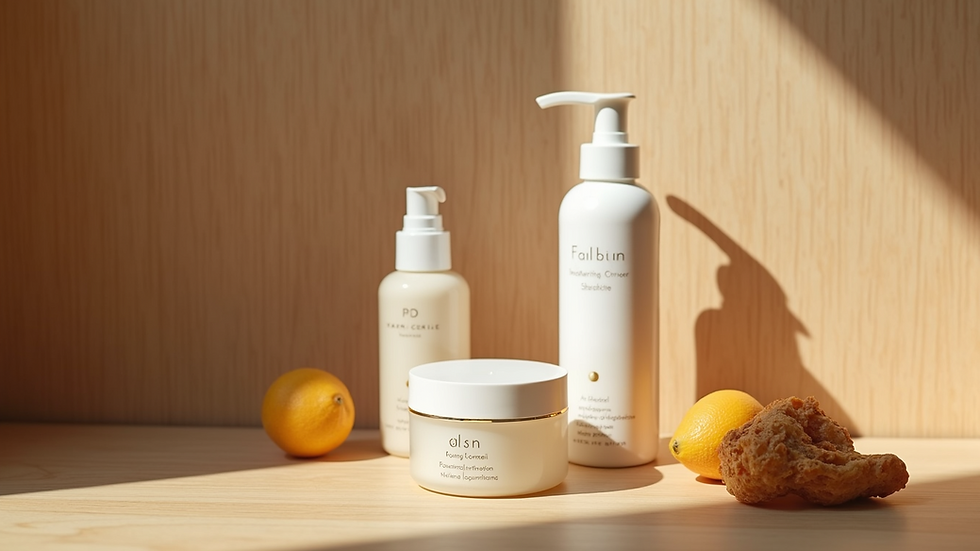How Custom Skincare Routines Can Transform Your Skin
- ifskincouldtalk

- Aug 25
- 3 min read
Every person’s skin is unique, with its own set of needs and challenges. This is why a one-size-fits-all approach to skincare often falls short. Custom skincare routines are designed to address your individual skin type, concerns, and lifestyle, offering a tailored path to healthier, glowing skin. In this article, we will explore how custom skincare routines can transform your skin, the benefits they offer, and practical steps to create your own personalized regimen.
Understanding the Importance of Custom Skincare
Custom skincare routines are built around the specific characteristics of your skin. Factors such as oiliness, dryness, sensitivity, and aging signs vary widely from person to person. When you use products that are not suited to your skin type, you risk irritation, breakouts, or ineffective results.
A custom skincare routine takes into account:
Your skin type (oily, dry, combination, sensitive)
Skin concerns (acne, hyperpigmentation, wrinkles)
Environmental factors (climate, pollution)
Lifestyle habits (diet, stress, sleep)
By addressing these factors, a custom routine helps balance your skin’s needs and promotes long-term skin health.

How Custom Skincare Routines Work
Creating a custom skincare routine involves several steps that ensure the products and methods you use are perfectly suited to your skin.
Skin Analysis
Begin by assessing your skin type and concerns. This can be done through self-observation or with the help of a skincare professional. Look for signs like dryness, oiliness, redness, or uneven texture.
Selecting Ingredients
Choose products with ingredients that target your specific issues. For example, salicylic acid is excellent for acne-prone skin, while hyaluronic acid is ideal for hydration.
Layering Products Correctly
The order in which you apply products matters. Typically, you start with the lightest texture (like serums) and move to heavier creams or oils.
Adjusting for Seasons and Changes
Your skin’s needs can change with the seasons or due to hormonal shifts. A custom routine allows flexibility to adapt accordingly.
Consistency and Patience
Results take time. Sticking to your routine consistently is key to seeing transformation.
By following these steps, you can build a routine that works effectively for your skin’s unique needs.
The Benefits of Custom Skincare
Custom skincare routines offer several advantages over generic products:
Improved Skin Health
Targeted ingredients help repair and protect your skin barrier, reducing irritation and sensitivity.
Enhanced Effectiveness
Products designed for your skin type work better, delivering visible results faster.
Cost Efficiency
Avoid wasting money on products that don’t suit your skin or cause adverse reactions.
Boosted Confidence
Healthy, radiant skin can improve your self-esteem and overall well-being.
Long-Term Maintenance
A personalized routine supports ongoing skin health, preventing future issues.

How to Build Your Own Custom Skincare Routine
Building a custom skincare routine can seem overwhelming, but breaking it down into manageable steps makes it easier.
Step 1: Identify Your Skin Type and Concerns
Oily Skin: Look for lightweight, non-comedogenic products.
Dry Skin: Choose hydrating and nourishing ingredients.
Combination Skin: Balance oil control and moisture.
Sensitive Skin: Use gentle, fragrance-free products.
Step 2: Choose Core Products
A basic routine includes:
Cleanser: Removes dirt and impurities without stripping moisture.
Toner: Balances pH and preps skin for treatment.
Serum: Delivers concentrated active ingredients.
Moisturizer: Locks in hydration and protects the skin barrier.
Sunscreen: Shields skin from harmful UV rays.
Step 3: Add Targeted Treatments
Depending on your concerns, add:
Exfoliants (chemical or physical) for texture and brightness.
Spot treatments for acne.
Anti-aging products with retinoids or peptides.
Step 4: Test and Adjust
Introduce new products one at a time to monitor how your skin reacts. Adjust based on results and seasonal changes.
Step 5: Seek Expert Advice if Needed
If you’re unsure, consulting a dermatologist or skincare expert can provide valuable guidance. They can recommend personalized skincare solutions tailored to your unique skin profile.
Tips for Maintaining Your Custom Skincare Routine
Consistency is crucial, but so is adapting your routine as your skin changes. Here are some tips to keep your routine effective:
Be Patient: Skin renewal cycles take about 28 days. Give products time to work.
Avoid Overloading: Using too many products can irritate your skin.
Stay Hydrated: Drink plenty of water to support skin health from within.
Protect Your Skin: Always apply sunscreen during the day.
Review Regularly: Reassess your skin’s needs every few months.

Embracing the Transformation
Custom skincare routines are more than just a beauty regimen - they are a commitment to understanding and caring for your skin in a way that suits you best. By investing time and effort into a personalized approach, you can achieve healthier, more radiant skin that reflects your unique beauty.
Remember, the journey to great skin is ongoing. With the right routine, patience, and care, your skin can transform and thrive like never before.



Comments